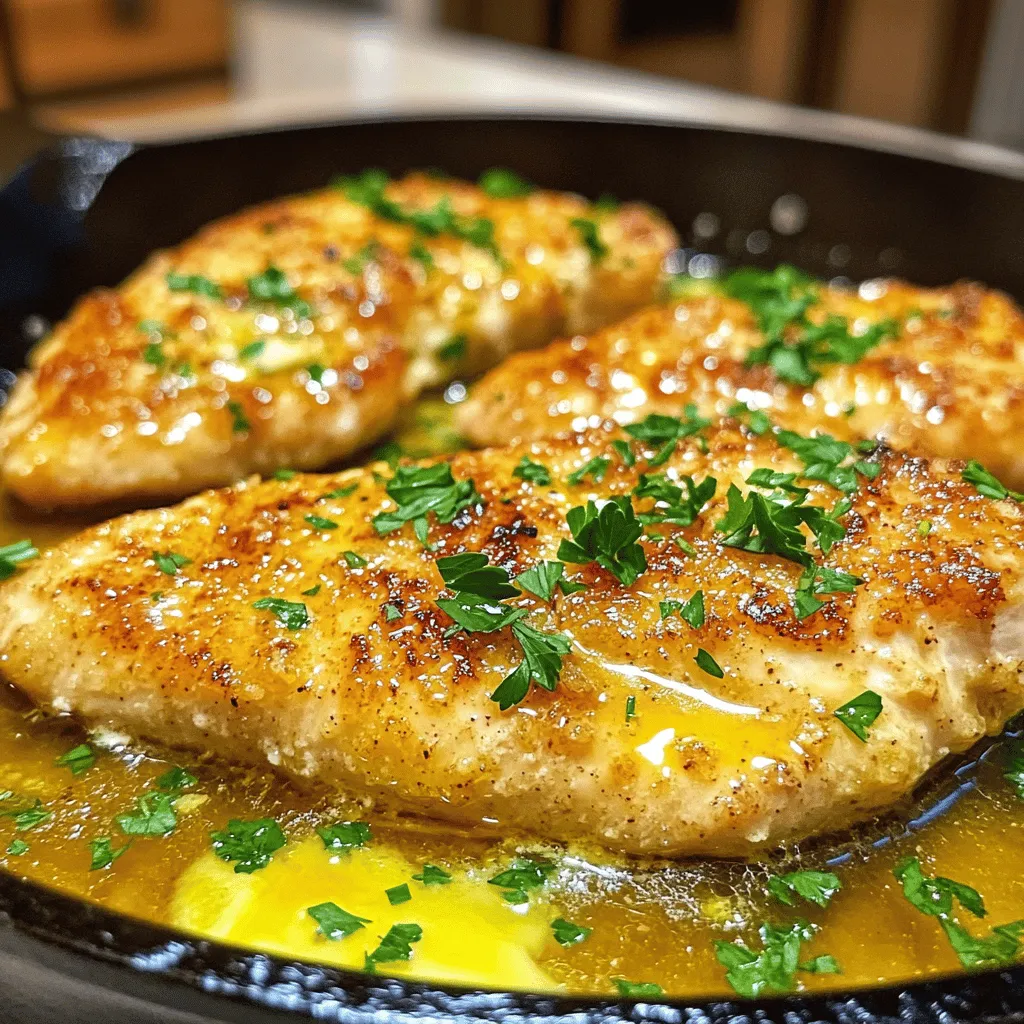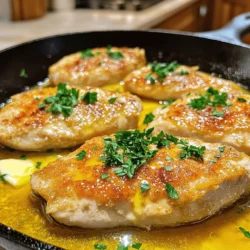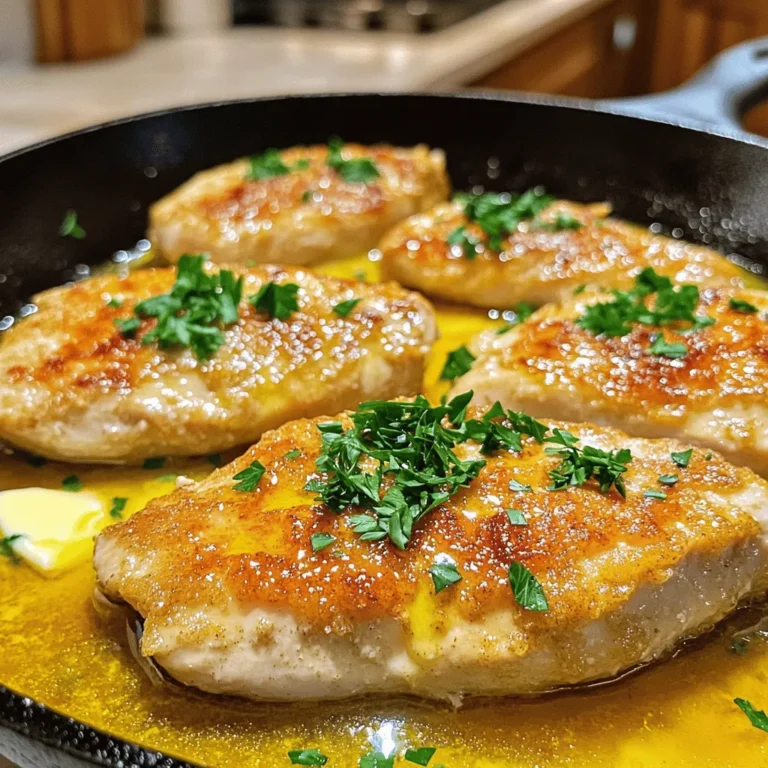Looking to impress at dinner with juicy, flavor-packed chicken breasts? You’ve landed in the right spot! In this guide, I’ll walk you through the simple process of making melt-in-your-mouth chicken breasts that everyone will love. With just a few key ingredients and straightforward steps, you’ll achieve perfect tenderness and taste. Get ready to transform your meals into a family favorite with this easy recipe!
Ingredients
Chicken and Marinade Components
– 4 boneless, skinless chicken breasts
– 1 cup buttermilk
Seasoning and Coating Ingredients
– 1 tablespoon garlic powder
– 1 tablespoon onion powder
– 1 teaspoon smoked paprika
– 1 teaspoon salt
– 1/2 teaspoon black pepper
– 1 cup all-purpose flour
– 1/4 cup cornstarch
Cooking Essentials
– 1/4 cup unsalted butter
– 2 tablespoons olive oil
– Fresh parsley for garnish
To create melt-in-your-mouth chicken breasts, start with the right ingredients. The chicken breasts should be boneless and skinless for tenderness. Buttermilk is key; it adds flavor and helps the chicken stay juicy.
Next, gather the seasoning and coating ingredients. Garlic powder and onion powder bring depth, while smoked paprika adds a nice touch. Salt and black pepper enhance all the flavors. The flour and cornstarch help create that golden crust when cooked.
Lastly, don’t forget the cooking essentials. Unsalted butter and olive oil work well for cooking. Fresh parsley brightens the dish and adds color.
Step-by-Step Instructions
Preparing the Marinade
To start, gather your marinade ingredients. In a large bowl, mix these items:
– 1 cup buttermilk
– 1 tablespoon garlic powder
– 1 tablespoon onion powder
– 1 teaspoon smoked paprika
– 1 teaspoon salt
– 1/2 teaspoon black pepper
Add the chicken breasts to this mixture, ensuring they are fully submerged. Cover the bowl and place it in the refrigerator. For the best results, let the chicken marinate for at least 1 hour. If you have time, marinating overnight will give even more flavor.
Prepping the Oven and Coating
Next, preheat your oven to 375°F (190°C). This step is crucial for even cooking. While the oven heats, prepare the coating. In a shallow dish, combine these two ingredients:
– 1 cup all-purpose flour
– 1/4 cup cornstarch
Mix them well. This mixture will create a crispy outer layer for your chicken.
Cooking Process
Now, let’s cook! Start by searing the chicken. In a large, oven-safe skillet, heat these:
– 1/4 cup unsalted butter
– 2 tablespoons olive oil
Heat them over medium-high heat. Once hot, take the chicken out of the marinade. Let any extra marinade drip off, then dredge each breast in the flour and cornstarch mixture. Press lightly to help it stick.
Place the coated chicken in the skillet. Sear for about 4-5 minutes on each side, or until golden brown.
After searing, transfer the skillet to the preheated oven. Bake for 20-25 minutes. To ensure it’s safe to eat, check that the internal temperature reaches 165°F (75°C). This will give you juicy, melt-in-your-mouth chicken breasts.
Once done, remove the skillet from the oven and let the chicken rest for 5 minutes before serving. This helps keep the juices in. For a beautiful touch, sprinkle fresh parsley on top before plating. Enjoy your delicious creation!
Tips & Tricks
Achieving the Perfect Texture
Marinating chicken is key for a great texture. I recommend marinating for at least one hour. This helps the chicken absorb flavors and stay juicy. For the best results, try marinating overnight. The longer the chicken sits, the more tender it becomes.
Searing is another important step. Make sure your skillet is hot before adding the chicken. This creates a nice crust. Cook each side for about 4-5 minutes until golden brown. Avoid flipping too early; let it form a crust first.
Flavor Enhancements
To boost the taste, add spices or herbs. Consider using fresh rosemary or thyme for a fragrant touch. You can also try adding a pinch of cayenne for heat or lemon zest for brightness. These add depth to the dish.
Choosing the right oil matters, too. Olive oil gives a rich flavor, but you can also use avocado oil. It has a high smoke point, ideal for searing. Don’t shy away from experimenting with different oils to find your favorite.
Serving Suggestions
Pair your chicken with side dishes that complement its flavors. Roasted vegetables or a simple salad work well. Creamy mashed potatoes or fluffy rice can also balance the meal.
For visual appeal, garnish your chicken with freshly chopped parsley. This adds a pop of color. You can also add lemon wedges on the side for a fresh touch. Presentation can make your meal feel special, even on a busy night.

Variations
Different Flavor Profiles
You can change the flavor of your melt-in-your-mouth chicken breasts easily. For an Asian twist, try a marinade made with soy sauce, ginger, and sesame oil. This gives a nice umami taste. You can also add a bit of honey for sweetness.
For a Mediterranean flavor, mix olive oil, lemon juice, and fresh herbs like thyme or rosemary. These herbs add a bright and fresh taste to the chicken. Each of these options changes the dish completely, making it exciting.
Cooking Method Alternatives
You can cook chicken breasts in different ways. Grilling gives the chicken a smoky flavor and nice grill marks. Just make sure to preheat your grill and oil the grates. Grill for about 6-7 minutes per side.
Baking is another great option. It keeps the chicken moist and juicy.
If you want even more tenderness, try slow cooking. Place the chicken in a slow cooker with your favorite sauce. Cook on low for 6-8 hours. This method makes the chicken super soft and easy to shred.
Dietary Modifications
If you need gluten-free options, use almond flour or gluten-free bread crumbs instead of all-purpose flour. This will still give you a nice crispy coating.
For a low-fat version, you can swap buttermilk for unsweetened yogurt. You can also use a light oil, like avocado oil, instead of butter. These small changes make the dish fit your dietary needs without losing flavor.
Storage Info
Refrigerating Leftovers
To keep your chicken fresh, let it cool down first. Place it in an airtight container. You can store it in the fridge for up to four days. This way, you can enjoy your melt-in-your-mouth chicken again soon!
Freezing Chicken
If you want to save it longer, freezing is a great option. Wrap the chicken tightly in plastic wrap, then place it in a freezer bag. Squeeze out the air before sealing. You can freeze cooked chicken for up to three months. When you’re ready to eat, thaw it in the fridge overnight for the best texture.
Reheating Instructions
To reheat your chicken, avoid the microwave if possible. Use the oven or stovetop for even heating. If using the oven, set it to 350°F. Heat until the internal temperature reaches 165°F. This keeps the meat moist. Watch the time closely to prevent overcooking. Enjoy your chicken just like the first time!
FAQs
How long should I marinate chicken breasts for the best results?
Marinating chicken breasts is key for flavor and tenderness. I recommend at least 1 hour for good results. However, for the best taste, try to marinate overnight. This allows the chicken to soak up all the flavors from the buttermilk and spices. The longer you marinate, the more the chicken becomes melt-in-your-mouth tender.
Can I use frozen chicken breasts for this recipe?
Yes, you can use frozen chicken breasts. Make sure to thaw them safely before marinating. The best way to thaw is in the fridge overnight. If you’re short on time, you can use the microwave to defrost them. Just be careful not to start cooking them. Once thawed, follow the marinating steps as usual.
What temperature should chicken be cooked to?
Cooking chicken to the right internal temperature is very important. The safe temperature is 165°F (75°C). Use a meat thermometer to check this. Cooking chicken to this temperature ensures it is safe to eat and juicy. Undercooked chicken can cause foodborne illnesses, so always check the temperature before serving.
In this blog post, we explored how to make juicy, flavorful chicken breasts. We discussed key ingredients, including the marinade, seasonings, and cooking essentials. I shared step-by-step instructions to ensure your chicken turns out perfectly. I also offered tips, flavor variations, and storage advice.
Remember, marinating is crucial for taste. Experiment with spices and sides to elevate your dish. Whether you bake, grill, or slow-cook, great chicken is within your reach. Enjoy your cooking journey!


